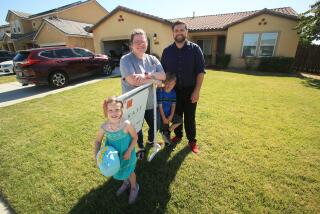Foreclosures expected to rise, pushing home prices lower
California and other states are likely to see an enormous wave of long-delayed foreclosure action in the coming year as banks deal more aggressively with 3.5 million seriously delinquent mortgages.
And experts said that dealing with the foreclosure process, from issuing notices of default to selling repossessed homes, is likely to push housing prices lower this year before the real estate market has a chance to recover.
A report from RealtyTrac, an Irvine data firm, said about 1.9 million U.S. homes were hit with default notices, foreclosures and other actions last year. That is down from 2.9 million in 2010. Seriously delinquent loans are defined as being four months in arrears.
“There were strong signs in the second half of 2011 that lenders are finally beginning to push through some of the delayed foreclosures in select local markets,” said Brandon Moore, chief executive of RealtyTrac. “We expect that trend to continue this year.”
The real estate market was in “full delay mode” last year on foreclosures as banks worked to correct legal problems with procedures in many states, Moore said.
In California, 3.2% of homes logged at least one foreclosure filing last year, down from 4.1% a year earlier. But regional differences continued: 2.7% received notices in Los Angeles County and 2.5% in Orange County, compared with nearly 5% in San Bernardino County and 5.3% in Riverside County.
California saw a second-half surge in initial notices of default — the first warnings that a bank is preparing to seize properties with delinquent mortgages, said RealtyTrac spokesman Daren Blomquist.
Though many more foreclosures are expected this year, the number still will be below the peak of 2010, Blomquist said.
Connie Der Torossian, co-president of the Orange County Home Ownership Preservation Cooperative, a nonprofit housing counseling agency, said the distressed homeowners she helps are getting loan modifications or sales dates from banks far faster than in the past. The days of troubled borrowers spending two years in foreclosure limbo are at an end, she said.
“We’re not seeing people have to wait six or seven months to get an answer,” she said. “It’s more like six or seven weeks.”
Worried that the foreclosure flood could further undermine the housing markets, the Federal Reserve urged Congress recently to do more for troubled homeowners.
Some Fed officials have been advocating reducing the loan principal more often for underwater borrowers, those whose homes are worth less than their mortgages. The central bank also has been urging mortgage giants Fannie Mae and Freddie Mac, kept alive by three years of taxpayer bailouts, to unload their backlogs of foreclosed properties in bulk discount sales to investors who would then rent out the properties.
That process, which Fannie and Freddie officials said is under study, could help stabilize the housing markets. However, in the short term it would increase taxpayers’ tab for propping up the government-sponsored housing finance firms, which already has reached about $150 billion.
Central bankers have tried to resuscitate the economy by keeping interest rates at record low levels. Celia Chen, a housing economist at Moody’s Analytics, said the Fed is now taking additional steps because the economy remains fragile and could tip back into recession.
However, Chen believes housing is “poised for better days” after the backlog of foreclosures is cleared away. She said housing is now undervalued, with prices compared to incomes well below the average over the last 20 to 30 years.
RealtyTrac reported a dip in foreclosure filings in December, but Chen said that appeared to be only a holiday hiatus by banks. She projected that home prices will trend slightly lower as the distress sales take place but will bottom out this year in California and the rest of the nation.
After that, Chen said, the improving economy could put the housing recovery in “full swing,” driving prices up nationally more than 5% in 2013 and 7% in 2014.
California home prices probably will track the national trend and hit bottom during the middle of this year, she said. However, prices will probably recover at a slower pace than much of the country because housing and unemployment problems run so deep in the Golden State.
The state’s difficulties were reflected in RealtyTrac’s report, which showed California with the third-highest incidence of foreclosure filings in 2011, behind only Nevada and Arizona.
However, analysts also said they expect housing in California to stabilize more quickly than in many states. The reason: a speedy foreclosure process that normally takes place without court action and is one of the most streamlined in the nation.
RealtyTrac said the average foreclosure took 352 days last year in California, down from a peak of 363 in 2010. By contrast, the foreclosure timeline was 806 days in Florida and 1,019 days in New York, both of which require extensive court review of foreclosures.
More to Read
Inside the business of entertainment
The Wide Shot brings you news, analysis and insights on everything from streaming wars to production — and what it all means for the future.
You may occasionally receive promotional content from the Los Angeles Times.











